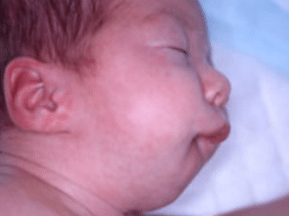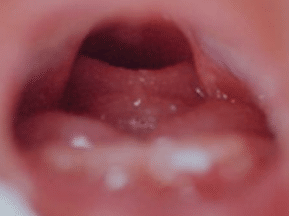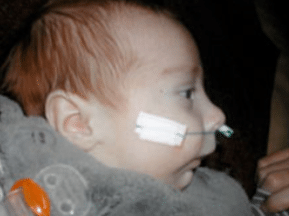The Pierre Robin syndrome is the association in a newborn of three signs: a cleft palate, a small chin (retrogenia) (photo 1) and a backwards fall of the tongue (lingual ptosis or glossoptosis).
During the formation of the fetus the tongue is vertical then lowers. If there is a lack of motor induction then the tongue remains vertical (lingual ptosis) it remains between the palatine blades and the palate does not close, the cleft palate is in a roman arch, it keeps the imprint of the tongue ( photo 2). The backwards drop of the tongue causes a lack of stimulation of the mandibular growth (retrognia).
A genetic origin for SPR has been discovered by research teams in France (INSERM U781) and Scotland. Non-coding sequences of the genome would act on a mandibular growth gene (SOX9 gene on chromosome 17).
This syndrome has dietary and respiratory consequences. There are several stages of gravity, and for each stage, there is a suitable treatment: position on the stomach, oxygen, probes, help the child to breathe better. In the most severe cases, a naso-pharyngeal tube must be placed in order to allow the child to oxygenate properly (photo 3). Similarly, if the bottle is always preferred to feed the child, sometimes it may be necessary to use a gastric tube. Neonatology monitoring and management may be required for a few weeks.
Cleft palate surgery is done between 4 and 6 months. The palate is closed as for any child with a cleft palate (see surgery of the palate). The subsequent growth of the mandible is stimulated by feeding, bottle-feeding, chewing.

Side view of a child with retro mandibulia

Cleft palate
The tongue rises in the palate and obstructs the respiratory system

Pharyngeal naso tube in place

Comments